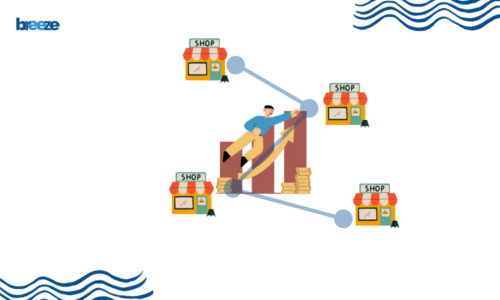- Payel Adhikary Ghosh
- Breeze, Field Sales Management, FSM
- 0 Comments
- 1779 Views
We all know that incoming leads are important, but equally vital is assigning these leads to the right person. In field sales, where every lead counts, lead routing emerges as the silent hero in the battle against lead slippage.
Lead routing involves distributing all incoming leads to the Sales Development Representatives (SDRs) with the intention that each lead will be nurtured by the appropriate team member. Lead assignment can be approached in two ways. It can be as simple as assigning leads to SDRs alphabetically, or it can be based on factors such as territory or potential deal size.
Effective lead routing is an essential tool that has repeatedly proven its worth in my efforts to boost sales team productivity and efficiency. Lead routing plays a pivotal role in preventing quality prospects from falling through the cracks. This is made possible when automated lead routing systems come into play.
Automated lead routing systems not only improve our response rate to each lead but also create a seamless experience for prospects. Just imagine: what if your leads inquired about your product and no one responded? It not only causes revenue loss but also leaves a bad taste in their mouths. A negative customer experience burns more than losing a prospect to your competitor due to mismatched requirements.
When you assign leads to your Sales Development Representatives (SDRs), you can also track their performance. Did they convert the deal and bring in more orders for your business, or did they fail? If they did fail, you can analyze the reasons properly. We mostly leverage lead scoring to prioritize high likelihood conversion leads, ensuring that they’re fast-tracked to the sales leaders or top-performing salespersons.
Through this article, you’ll dive into key strategies for effective lead routing and how to overcome common challenges, armed with insights from companies that have led the way in lead-routing technology.
Key Strategies for Effective Lead Routing
Implementing effective lead routing has been transformative. Here’s a dive into the strategies that ensure leads are not just captured but actively ushered towards successful conversion:
- Qualification and Sorting:
At the onset, we establish if a lead represents a new prospect or an existing customer, which dictates the next steps of engagement. We employ a system that scrutinizes leads based on predefined criteria such as deal size, industry relevance, and specific use cases. Moreover, lead scoring enables us to measure a lead’s engagement and qualification status as they progress through the sales funnel, ensuring only the warmest leads are pursued by the team.
- Routing Criteria and Prioritization:
Setting up clear routing criteria is crucial for delivering leads to the right sales representative without delay. We match leads to reps by considering factors like the lead source, territorial alignment, and the structure of the sales team. This strategy prevents the duplication of efforts when dealing with known leads or customers, linking them back to their original account owners. The use of marketing forms and data enrichment tools has proven invaluable in collecting high-quality lead data for this purpose.
- Efficiency and Experience:
The swiftness with which we contact a lead can make or break a deal. By assigning leads promptly and accurately, we’ve significantly shortened our lead response time, which has had a tangible impact on our conversion rates. This efficiency not only augments the customer’s experience but also enhances the customer’s lifetime value to our business. It’s about striking the right balance — providing reps with enough detail to understand the lead without getting bogged down by overly-prescriptive information.
With each of these strategies, our aim is always clear: to manage leads with precision and agility. By refining our lead routing system continuously, we further our pursuit of excellence in field sales and customer satisfaction.
Overcoming Common Lead Routing Challenges
Overcoming the challenges in lead routing is a pivotal step in refining our field sales operations. It’s startling yet true, according to study, that about 28% of marketing-generated leads are incorrectly assigned to the wrong account owner. This inefficiency can cause friction and missed opportunities within sales teams. Our approach to circumvent this pitfall involves a nuanced understanding of the distinctive roles of sales and marketing teams. Often, there’s a divide in these teams’ perceptions – with only 30% of marketing leaders convinced that sales will follow up on their leads, contrasting sharply with the 61% of confident sales leaders.
To tackle these common issues and elevate our lead routing process, we incorporate tools such as BreezeFSM. BreezeFSM aids us in sophisticated lead segmenting and routing, efficient lead assignment, and managing rep availability, along with holistic data management. We adhere to best practices for lead routing that include assigning leads to dedicated contacts, collecting in-depth information through form fields, applying consistent reassignment rules, and deploying a thorough onboarding strategy. Our commitment to data quality is unwavering; we preempt lead routing issues with proactive measures including cleaning data prior to routing, automatic processing of lists, adoption of data-driven technologies, and automated ‘black hole’ recovery—to ensure no lead is left behind.
Conclusion
In conclusion, effective lead routing is paramount in harnessing the full potential of every sales opportunity and preventing lead slippage. Throughout this article, we’ve distilled the essence of impactful lead routing practices and how they translate into heightened sales performance. By implementing a robust lead routing system, underpinned by clear criteria and swift response mechanisms, my team and I have managed to not only optimize our sales process but also significantly enhance the customer experience.
The strategies and solutions discussed serve as a testament to the transformative power of organized lead management and its widespread implications. As field sales teams strive for efficiency, adopting these practices ensures that high-quality leads are handled by the right representatives at the right time, fostering improved conversion rates and business growth. I encourage all sales teams to reflect on these insights, tailor their lead routing processes accordingly, and continue to explore tools and methods that drive sales success in today’s competitive landscape.
FAQs
What is Lead Routing and Why is it Important?
- Lead routing, at its core, is the process we use to assign new leads to suitable sales representatives according to defined rules. This is done to ensure that the chances of converting a lead are maximized by having the most qualified rep respond in a timely manner.
- By implementing lead routing in our workflow, we’ve seen improved management of leads, resulting in faster response times to inquiries, which heightens the likelihood of closing deals.
How Can Lead Routing Be Customized?
- There are several criteria that can be employed when setting up routing rules. Personally, I ensure we consider factors like territorial coverage, the complexity and value of the deal, the rep’s area of expertise, and whether the lead relates to a product or service we’ve tagged as a priority. By incorporating these custom rules, we take the guesswork out of which rep a lead should go to.
- For automation, we utilize software like Salesforce which seamlessly integrates lead routing features. This enables us to not only assign leads efficiently but also provide thorough reporting and analysis of our performance.
Are There Tools to Help Manage Lead Routing in CRMs like Salesforce?
- Indeed, to combat common data-related issues such as outdated information or duplicate leads, my team has turned to tools like BreezeFSM. This powerful tool helps with advanced lead segmenting, assignment balance, merging duplicates, and it even automates lead-to-account matching.
- Best practices we adhere to include defining a clear lead routing strategy, setting up lead scoring to prioritize prospects, ensuring the collection of high-quality lead data, and consistently reassessing and updating these processes to maintain relevance and accuracy.
While challenges may arise, such as incomplete data or complex routing rules, understanding these FAQs and leveraging the right tools are essential steps towards a fluid and successful lead routing system that benefits everyone involved, especially our prospects and customers.





